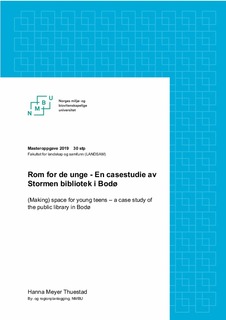| dc.description.abstract | Public spaces has always been a subject of general interest and controversy. It has also increasingly become a topic of academic interest, nourished by theories of planning as well as normative ideas about what public spaces should be and how their many social functions best can be fulfilled. This master thesis focuses on the library as an indoor public room, and regard it from the point of view of the urban youth. It takes the newly built library in Bodø, Stormen, as its case study, and asks if and how young people (age 13-19 years old) were involved in its conception, and how they perceive and use it, once built.
The inquiry makes use of Lefebvres three categorizations of room; “spatial practice”, “representational space” and “representations of space”, concepts I for the ease of understanding have renamed as “the perceived room”, "the intended room" and “the appropriated room”.
By field observation, interviews and document reviews, I try to establish to what degree youth were involved in the decision making process and to what degree they have taken ownership of the library as it stands now, in particular with regard to the rooms designed for them as a target group.
My findings suggest that they had little influence in the conception of the library, but that targeted program to involve the youth in activities within the library has succeeded in making them use the facilities. This use differs slightly from what we associate with a library, indicating that it serves several functions, including a social meeting place.
The thesis also looks at how libraries in general have social functions, typical to public spaces. Although Stormen also here is the main focus, the thesis draws on several academic studies, indicating that libraries may fulfil several social functions, but that at the same time, there are limitations, given by the fact the libraries have a primarily are meant to be a place for silent contemplation and borrowing of books.
The challenge to urban planners remains familiar: how to create new or at least additional use of old institutions like the library, treating them as a public spaces with a social mission. | nb_NO |

